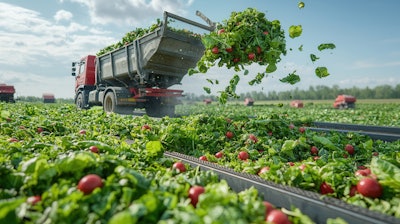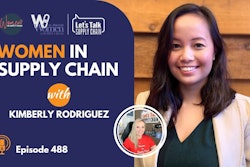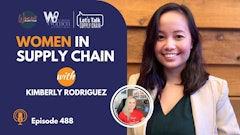
Every food company tracks the distribution of its products. But there is often less visibility into how to reduce waste and its impact on the bottom line. As regulations tighten and disposal costs rise, waste is quickly becoming one of the supply chain’s most under-examined risks.
Food loss and waste happen quietly –spoilage during transit, byproducts of food processing, disposing of packaging, product mislabeling, damaged packaging, and overproduction. All of this leads to food leaving the supply chain before it ever reaches a customer. These losses are often handled separately from core operations, with little transparency across teams or systems.
That separation is becoming harder to justify. Regulators, investors, and internal stakeholders are now asking more pointed questions: Where does the waste go? How is it handled? And can you prove it through measurement and data?
Answering those questions requires a new approach, one that treats wasted food as a traceable, reportable output rather than an unavoidable cost.
Regulations are raising the stakes
Across the country, new rules are reshaping how companies must manage and report on food waste. Several states have already enacted bans on landfills for organic material. Others are introducing emissions reporting requirements or offering diversion incentives tied to specific eligibility criteria. These policies are transforming what compliance entails for industrial food operations.
These new regulations are also changing expectations. Food businesses are being asked to document what they discard, how it’s handled, and the resulting environmental impacts. This level of transparency requires coordination among logistics, operations, and waste service providers, making diversion a more visible part of supply chain performance.
Companies that treat waste as a measurable output will be better prepared to meet these expectations and respond to the next wave of regulatory pressure.
Measuring what was once ignored
Historically, food waste was managed at the facility level. It was logged as shrink, categorized as disposal, and sent off-site. Once it left the building, it typically left the company’s field of view.
That approach worked when disposal was low-cost and lightly regulated. But the environment has shifted. Waste disposal is now a significant line item, particularly for food businesses that generate large amounts of waste. Many companies are paying twice — once to procure the food, and again to haul it away. Those costs add up quickly across a distributed network of warehouses, stores, and distribution centers.
Beyond the financial burden, poor documentation introduces operational risk. Branded or recalled goods that are not properly disposed of through secure, certified destruction may reenter the market. Incomplete records can complicate audits or delay sustainability disclosures. Over time, these gaps can undercut compliance and damage credibility.
Bringing waste into view helps reduce those risks. And it also helps surface insights that would otherwise go unnoticed.
Making waste part of the supply chain conversation
Wasted food affects more than environmental metrics. It creates inefficiencies in procurement and inventory, complicates product recalls, inflates transportation costs, and undermines customer trust. That reach makes it a supply chain concern, and an important, strategic one.
When waste data becomes part of the operational toolkit, it unlocks new insights. A packaging change that increases spoilage or a recurring bottleneck that results in excess inventory may not surface through traditional reporting. But waste tracking can bring those patterns to light and support smarter upstream decisions.
Integrating waste data into facility reporting or dashboards also helps standardize performance across teams. Waste volumes and causes can vary by region or season, but when teams have access to consistent data, they can adapt faster and share effective practices.
Choosing the right waste diversion strategy for your business
A single day’s waste stream at a processing facility may include palletized beverages past their expiration date, damaged packaged goods, bulk liquids from production lines, and slurries that never made it to final packaging. Each of these materials introduces different handling requirements, and not all diversion strategies are equipped to manage them at scale.
Composting, although valuable, has its limitations. High-moisture materials, such as dairy products or meat, are often not accepted. Contamination concerns can – and often should – also restrict the types of materials that can be processed. Even donations, though critically important, depend on packaging integrity, consistent labeling, and clear use-by dates. Not to mention, many depackaging solutions shred or crush food, which releases microplastics into waste streams that then contaminate water and farmland.
As diversion needs grow more complex, many food businesses are turning to anaerobic digestion. This method can handle a wider range of materials, including packaged and liquid waste, and convert them into new, valuable resources, like renewable energy and soil amendments. Plus, this process can use responsible depackaging solutions that gently separate packaging from food to eliminate microplastics and protect the environment. More importantly, anaerobic digestion often comes with verified reporting that details what was processed, how it was managed, and the resulting environmental impact. That kind of visibility is becoming increasingly essential, not just for compliance, but also for internal decision-making and corporate reporting.
In today’s operating environment, the method of diversion matters, but the ability to measure and document its outcomes matters just as much.
A clearer future starts with better visibility
Food waste has long existed at the margins of supply chain oversight. But that’s changing. Regulatory pressure is growing, stakeholder expectations are rising, and internal systems are becoming increasingly data driven. Waste that was once quietly discarded now demands a clear line of sight.
Companies that act now can build systems that scale with them. They can set consistent standards, reduce risk, and bring transparency to one of the supply chain’s most overlooked areas. They can also position themselves to lead on an issue that will only grow more important with time.
In an industry built on movement, what happens to food that doesn't reach the shelf matters more than ever. Waste deserves a place in the conversation, not just because of what it costs, but because of what it reveals.

















